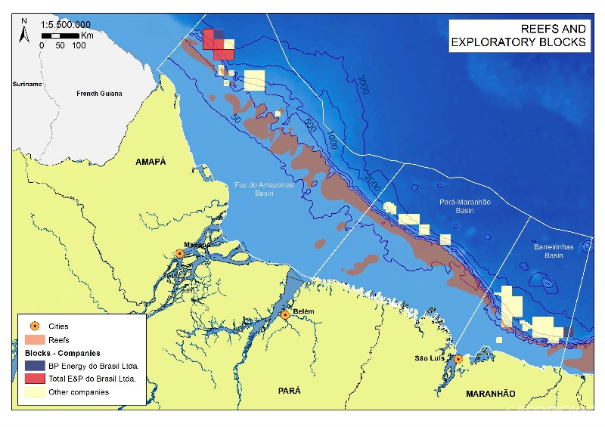
Company starts strategy to improve the image of the exploration in the region before the French public opinion
December 12, 2018
Four days after Ibama’s refusal to license blocks in Foz do Amazonas, Total began a campaign on Tuesday to improve the image of the company’s exploration projects in the region.
Total was authorized on October 22 by the French government to send a drilling rig to the territory of French Guyana where a series of exploration prospects begin soon 150 km from the coast.
In a press release the company sought to reinforce its commitment to operate with transparency and invited NGOs to visit the site.
Ibama’s refusal last week was celebrated by environmentalists in France, where engaging in environmental causes has mobilized thousands of people. Jean-François Julliard, director of Greenpeace in France, said that Ibama’s decision was “at last a good news for the climate” and “an immense victory after two years of intense efforts.” On the day of the decision, the NGO published an article in which it classifies the denial as “a historic victory for the Amazon reef.”
Ironically, the rise in diesel prices announced by the French government of Emmanuel Macron at the turn of the month to discourage the use of fuel and favor gasoline was the fuse that drove thousands into the streets in the protests of gilet jaunes (yellow vests) . Shortly after the start of the protests, Macron froze the increase and fossil fuels and light, but the measure was not able to end the demonstrations.
In Total’s statement yesterday, Total said it was not drilling near coral reefs and stressed that “the nearest reef identified is 30 kilometers away and is not a coral.” Total was licensed to operate in the area in 2001 and requested an extension of that license in 2016, which was granted in September 2017.
150 kilometers off the coast and in deep water, the permit area covers an extension of 24,000 square kilometers beyond the continental shelf of Guyana. The drilling area is located at the center of this area, at 2,000 meters deep. The company’s goal, the statement said, is to drill a last exploration well, following the five points already drilled between 2011 and 2013, “in order to definitively conclude if the exploration phase is relevant.”
Corals of the Amazon as an area of permanent preservation
In Brazil, the permission for oil companies to prospect in Foz do Amazonas continues as a controversial issue. The exploration projects in the region have been facing strong resistance from environmentalists and a great demand for data and information from Ibama. Licensing is accompanied by environmental conservation organizations due to the discovery of an area – at least 9.5 km2 – dominated by a rare coral reef, able to survive in the murky waters of the Amazon. Earlier this year, Greenpeace launched an international campaign to mobilize against oil exploration in the region titled “Defend the Corals of the Amazon.”
Exploration projects also face resistance in Congress. Two bills filed this year (PLs 10333/2018 and 11030/2018) want to make the Amazon corals a permanent preservation area. They are authored by deputies Carlos Gaguim (DEM / TO) and Veneziano Vital do Rêgo (PSB / PE).
The re-elected governor of Amapá, Waldez Góes (PDT), is in favor of exploring the area. In June of 2015 he held a meeting with Total and BP representatives in which he blessed his government’s support for exploration in Foz do Amazonas. But the French company chose Belém do Pará as a logistics base for its campaign at the mouth of the Amazon.
In March BP gave up trying to prospect in the region. The company returned to the National Petroleum Agency (ANP) the concession of exploratory blocks FZA-M-257 and FZA-M-324, in shallow waters of Foz do Amazonas, for more than R $ 30 million.


Leave a Reply